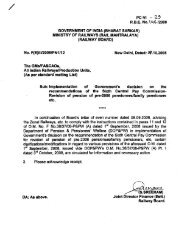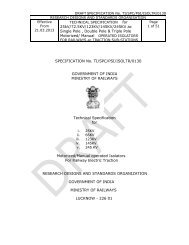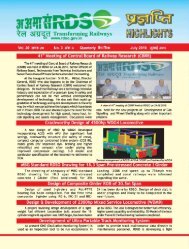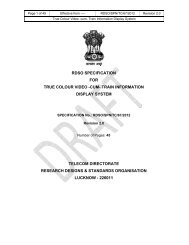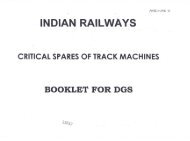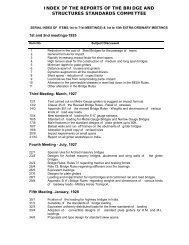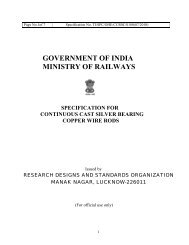SPECICATION NO. ETI/PSI/144 (12/91) SPECIFICATION FOR ... - rdso
SPECICATION NO. ETI/PSI/144 (12/91) SPECIFICATION FOR ... - rdso
SPECICATION NO. ETI/PSI/144 (12/91) SPECIFICATION FOR ... - rdso
Create successful ePaper yourself
Turn your PDF publications into a flip-book with our unique Google optimized e-Paper software.
main control and relay panel, 240V a.c. and 110V d.c. distribution board, 110V battery<br />
chargers, telephone apparatus as well as RTU(S). The battery room will house the 110V<br />
and telephone batteries. A Typical layout of the control room building is indicated in Drg.<br />
No.<strong>ETI</strong>/<strong>PSI</strong>/0238. Mod.B at Appendix.3.<br />
5.2.2 A small masonary building will be provided by the Railways at each SP,<br />
SSP and ATP, having an equipment room and a battery room. The equipment room will<br />
house RTU, battery charger, terminal board, 240V a.c. distribution board and telephone<br />
apparatus. The battery room will house 110V and telephone batteries. A typical layout is<br />
indicated in Drg. No.<strong>ETI</strong>/<strong>PSI</strong>/0010, Mod.D Appendix 4.<br />
5.2.3 The buildings at controlled stations are not air- conditioned. Suitable<br />
illumination inside the rooms shall be provided by the Railways.<br />
5.3 Operation of circuit breakers, interruptors and motor operated isolators at<br />
controlled stations<br />
5.3.1 The closing and tripping circuits of the circuit breakers, interruptors and<br />
motor-operated isolators are designed to operate off 110V battery supply, the batteries<br />
being provided by the Railways.<br />
5.3.2 Interposing contractors, for operating the closing and tripping circuits from<br />
RCC shall form part of the SCADA equipment. The contractor shall be suitable for 110V<br />
d.c. supply varying from +10% to -15%. The contacts of contractors shall have a<br />
continuous current carrying capacity of 10A, making capacity of 20A and breaking<br />
capacity of 2A inductive load. The contacts are liable to damage due to breaking of<br />
inductive current in the trip/closing coil circuits and therefore an arrangement for spark<br />
quenching, if necessary, shall be provided. Besides, the interposing contractors shall be<br />
so designed that it remains energised for a period adjustable between 500ms and 2s,<br />
arrangement for which shall be provided on the control output card in the RTU. These<br />
measures are required to prevent damage to the contacts.<br />
5.4 Monitoring of the state of catenary<br />
Outdoor type 27.5kV/110V, 100VA potential transformers are installed at<br />
the controlled stations by the Railways for monitoring the state of sub-sectors of the<br />
catenary i.c. Whether energized or not and for under-voltage relay operation at the SPs.<br />
The catenary voltage sensing shall be done through rectifier and solid-state comparator<br />
circuits so designed that the de-energised indication on the MDB/VDU appears at a<br />
voltage selectable between 50% and 70% and disappears between 60% and 80% of the<br />
rated voltage viz 110V a.c.<br />
5.5 Telesignals and their monitoring<br />
5.5.1 The various telesignale from typical TSS, SSP, SP and ATP in a double line<br />
section to the master station are as under:<br />
I. From each TSS<br />
(a) Name of telesignal<br />
1. 110V d.c. low.<br />
2. 240V a.c. fail.<br />
3. Catenary-1 fail/feeder-1 P.T. fuse fail.*<br />
4. Catenary-2 fail/feeder-1 P.T. fuse fail.*<br />
5. Catenary-3 fail/feeder-2 P.T. fuse fail.*<br />
6. Catenary-4 fail/feeder-2 P.T. fuse fail.*<br />
- 7 -



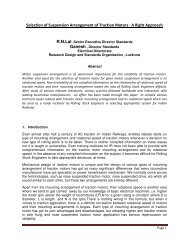

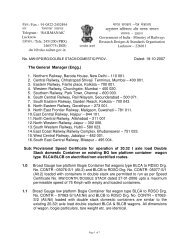
![Hkkjrljdkj] jsy ea= ky; vuql a/ kkuvfHkdYivkSj ekudlax Bu y ... - rdso](https://img.yumpu.com/21978459/1/184x260/hkkjrljdkj-jsy-ea-ky-vuql-a-kkuvfhkdyivksj-ekudlax-bu-y-rdso.jpg?quality=85)

